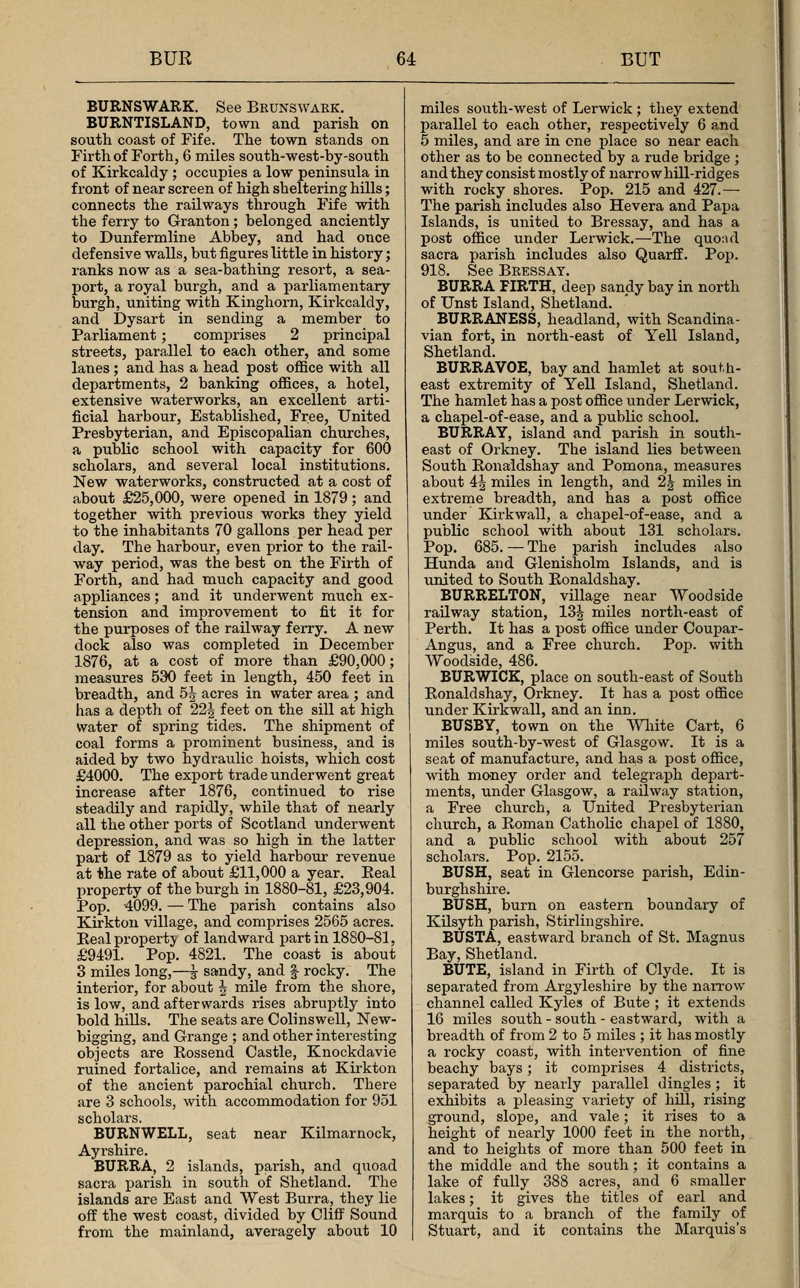BURNSWARK.
BURNTISLAND, town and parish on south coast of Fife. The town stands on Firth of Forth, 6 miles south-west-by-south of Kirkcaldy ; occupies a low peninsula in front of near screen of high sheltering hills ; connects the railways through Fife with the ferry to Granton ; belonged anciently to Dunfermline Abbey, and had once defensive walls, but figures little in history ; ranks now as a sea-bathing resort, a sea-port, a royal burgh, and a parliamentary burgh, uniting with Kinghorn, Kirkcaldy, and Dysart in sending a member to Parliament ; comprises 2 principal streets, parallel to each other, and some lanes ; and has a head post office with all departments, 2 banking offices, a hotel, extensive waterworks, an excellent artificial harbour, Established, Free, United Presbyterian, and Episcopalian churches, a public school with capacity for 600 scholars, and several local institutions. New waterworks, constructed at a cost of about 25,000, were opened in 1879 ; and together with previous works they yield to the inhabitants 70 gallons per head per day. The harbour, even prior to the rail-way period, was the best on the Firth of Forth, and had much capacity and good appliances ; and it underwent much ex-tension and improvement to fit it for the purposes of the railway ferry. A new dock also was completed in December 1876, at a cost of more than 90,000; measures 530 feet in length, 450 feet in breadth, and 5 acres in water area ; and has a depth of 22^ feet on the sill at high water of spring tides. The shipment of coal forms a prominent business, and is aided by two hydraulic hoists, which cost 4000. The export trade underwent great increase after 1876, continued to rise steadily and rapidly, while that of nearly all the other ports of Scotland underwent depression, and was so high in the latter part of 1879 as to yield harbour revenue at the rate of about 11,000 a year. Eeal property of the burgh in 1880-81, 23,904. Pop. 4099. The parish contains also Kirktou village, and comprises 2565 acres. Real property of landward part in 1880-81, 9491. Pop. 4821. The coast is about 3 miles long, J sandy, and rocky. The interior, for about mile from the shore, is low, and afterwards rises abruptly into bold hills. The seats are Colinswell, Newbigging, and Grange ; and other interesting objects are Rossend Castle, Knockdavie ruined fortalice, and remains at Kirkton of the ancient parochial church. There are 3 schools, with accommodation for 951 scholars.
BURNWELL, seat near Kilmarnock, Ayrshire.
BURRA, 2 islands, parish, and quoad sacra parish in south of Shetland. The islands are East and West Burra, they lie off the west coast, divided by Cliff Sound from the mainland, averagely about 10 miles south-west of Lerwick ; they extend parallel to each other, respectively 6 and 5 miles, and are in cne place so near each other as to be connected by a rude bridge ; and they consist mostly of narrow hill-ridges with rocky shores. Pop. 215 and 427. The parish includes also Hevera and Papa Islands, is united to Bressay, and has a post office under Lerwick. The quo:id sacra parish includes also Quarff. Pop. 918.
BURRA FIRTH, deep sandy bay in north of Unst Island, Shetland.
BURRANESS, headland, with Scandinavian fort, in north-east of Yell Island, Shetland.
BURRA VOE, bay and hamlet at south-east extremity of Yell Island, Shetland. The hamlet has a post office under Lerwick, a chapel-of-ease, and a public school.
BURRAY, island and parish in south-east of Orkney. The island lies between South Ronaldshay and Pomona, measures about 4J miles in length, and 2.^ miles in extreme breadth, and has a post office under Kirkwall, a chapel-of-ease, and a public school with about 131 scholars. Pop. 685. The parish includes also Hunda and Glenisholm Islands, and is united to South Ronaldshay.
BURRELTON, village near Woodside railway station, 13J miles north-east of Perth. It has a post office under Coupar-Angus, and a Free church. Pop. with Woodside, 486.
BURWICK, place on south-east of South Ronaldshay, Orkney. It has a post office under Kirkwall, and an inn.
BUSBY, town on the White Cart, 6 miles south-by-west of Glasgow. It is a seat of manufacture, and has a post office, with money order and telegraph departments, under Glasgow, a railway station, a Free church, a United Presbyterian church, a Roman Catholic chapel of 1880, and a public school with about 257 scholars. Pop. 2155.
BUSH, seat in Glencorse parish, Edinburghshire.
BUSH, burn on eastern boundary of Kilsyth parish, Stirlingshire.
BUSTA, eastward branch of St. Magnus Bay, Shetland.
BUTE, island in Firth of Clyde. It is separated from Argyleshire by the narrow channel called Kyles of Bute ; it extends 16 miles south-south-eastward, with a breadth of from 2 to 5 miles ; it has mostly a rocky coast, with intervention of fine beachy bays ; it comprises 4 districts, separated by nearly parallel dingles ; it exhibits a pleasing variety of hill, rising ground, slope, and vale ; it rises to a height of nearly 1000 feet in the north, and to heights of more than 500 feet in the middle and the south ; it contains a lake of fully 388 acres, and 6 smaller lakes; it gives the titles of earl and marquis to a branch of the family of Stuart, and it contains the Marquis's magnificent re-constructed seat of Mount Stuart. Pop. 10,998.

